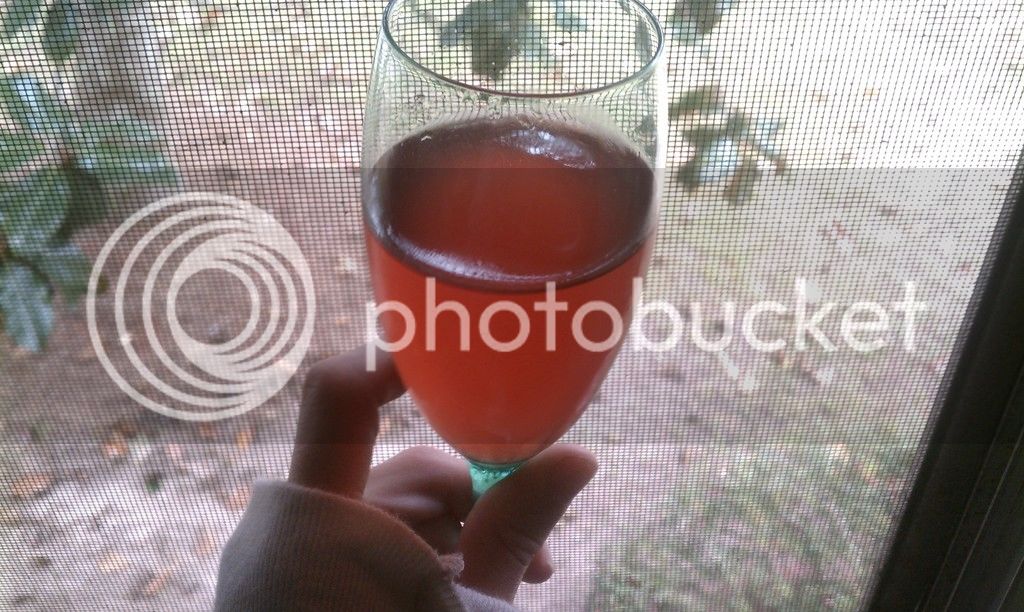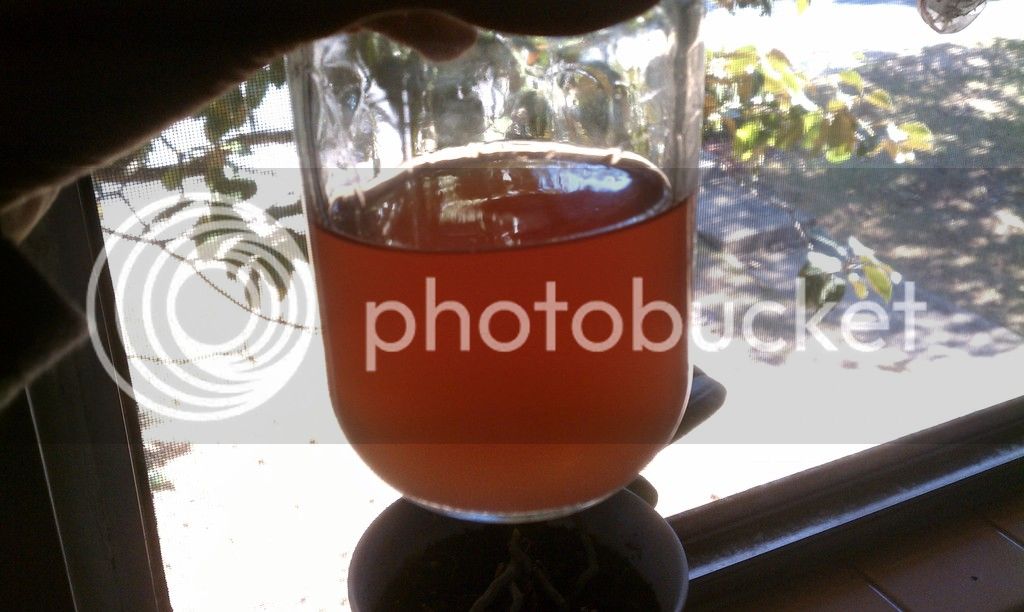winetortoise
Junior
- Joined
- Sep 21, 2015
- Messages
- 27
- Reaction score
- 3
I'm wondering whether this wine will be strong enough...
I filled one third of the 6 liter pot with beautyberries. I tried to use an over-the-top amount of beautyberries, because I noticed the last batch of fruit wine I made had such a high alcohol content that it made the wine taste somewhat watery at first. Also, because they have such a mild flavor, I figured that more was called-for, and I wanted some color whereas I've read that some people weren't able to retain it in theirs.
http://s1222.photobucket.com/user/son_of_dhamma/media/IMAG0613.jpg.html?sort=3&o=3
I mashed and mixed them and extracted the juice, then diffused in about
5 1/2 -to- 6 pounds of sugar. The fluid water was approximately
6- liters before ingredients, that's 1.6 gallons.
(One packet 7 grams yeast)
When all was room temperature, I added the already started yeast guys into the wine must. The next day, there was a piping little cap:
http://s1222.photobucket.com/user/son_of_dhamma/media/IMAG0618.jpg.html?sort=3&o=1
After plunging the cap never really foamed up again, just like with the last wine. I figured that's normal, but this wine doesn't bubble up as much as the previous wine had done. Here is the previous blueberry with strawberry-apple wine:
http://s1222.photobucket.com/user/son_of_dhamma/media/IMAG0540.jpg.html?sort=3&o=4
Yet this is the second and third day's bubbling of the beautyberry batch:
http://s1222.photobucket.com/user/son_of_dhamma/media/IMAG0620.jpg.html?sort=3&o=0
This beautyberry wine has twice the amount of water, but I used one packet of the same (Flieshcmann's) yeast for both. I'm wondering if the reason that there is less bubbling could be that there is half the relative amount of yeast than before, or perhaps that I have not used enough sugar to make a strong wine. The last wine was very strong, overwhelming the flavor and having a hot aroma. I like that a lot and so I'm concerned that this wine might not have the sugars it needs to become strong like the previous wine had.
I'm thinking that more sugar would be enough to remedy that, but perhaps the lower amount of bubbling is to be expected in a mild, less acidic fruit?--as opposed to the blueberries, strawberries and an apple. Perhaps I am worried for nothing. I may add some more simple-sugar if necessary a little later to ensure higher alcohol.
I filled one third of the 6 liter pot with beautyberries. I tried to use an over-the-top amount of beautyberries, because I noticed the last batch of fruit wine I made had such a high alcohol content that it made the wine taste somewhat watery at first. Also, because they have such a mild flavor, I figured that more was called-for, and I wanted some color whereas I've read that some people weren't able to retain it in theirs.
http://s1222.photobucket.com/user/son_of_dhamma/media/IMAG0613.jpg.html?sort=3&o=3
I mashed and mixed them and extracted the juice, then diffused in about
5 1/2 -to- 6 pounds of sugar. The fluid water was approximately
6- liters before ingredients, that's 1.6 gallons.
(One packet 7 grams yeast)
When all was room temperature, I added the already started yeast guys into the wine must. The next day, there was a piping little cap:
http://s1222.photobucket.com/user/son_of_dhamma/media/IMAG0618.jpg.html?sort=3&o=1
After plunging the cap never really foamed up again, just like with the last wine. I figured that's normal, but this wine doesn't bubble up as much as the previous wine had done. Here is the previous blueberry with strawberry-apple wine:
http://s1222.photobucket.com/user/son_of_dhamma/media/IMAG0540.jpg.html?sort=3&o=4
Yet this is the second and third day's bubbling of the beautyberry batch:
http://s1222.photobucket.com/user/son_of_dhamma/media/IMAG0620.jpg.html?sort=3&o=0
This beautyberry wine has twice the amount of water, but I used one packet of the same (Flieshcmann's) yeast for both. I'm wondering if the reason that there is less bubbling could be that there is half the relative amount of yeast than before, or perhaps that I have not used enough sugar to make a strong wine. The last wine was very strong, overwhelming the flavor and having a hot aroma. I like that a lot and so I'm concerned that this wine might not have the sugars it needs to become strong like the previous wine had.
I'm thinking that more sugar would be enough to remedy that, but perhaps the lower amount of bubbling is to be expected in a mild, less acidic fruit?--as opposed to the blueberries, strawberries and an apple. Perhaps I am worried for nothing. I may add some more simple-sugar if necessary a little later to ensure higher alcohol.
Last edited:











































![[Upgraded] 9Pcs Tree Root Growing Box with Drain Holes, Half Transparent Plant Rooting Propagation Ball & Metal Core Twist Ties, for Fast Propagation Plants (Size M)](https://m.media-amazon.com/images/I/514MWQxtWOL._SL500_.jpg)












